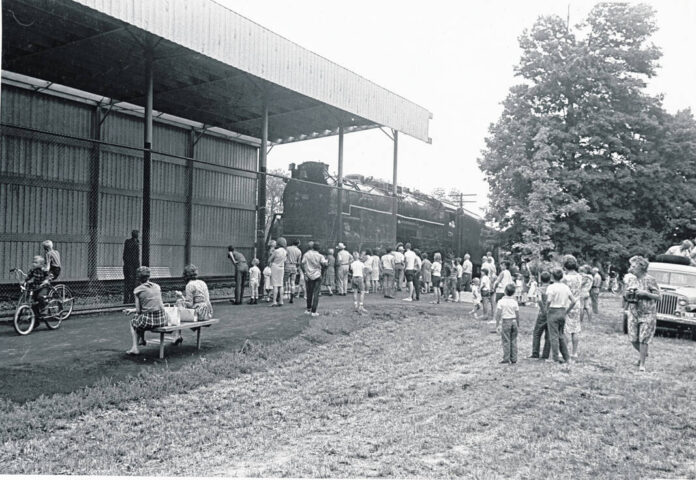
In this July 1966 photograph taken by Henry Koch, Nickel Plate engine 779 is pushed into its exhibit space in Lincoln Park. The steam engine, which was rolled out in May 1949, was the last produced by Lima-Hamilton Corp., the successor to the old Lima Locomotive Works. Koch was a longtime member of the Lima Camera Club and presented this photograph and others to the Allen County Historical Society when the rail exhibit was dedicated July 10, 1966.
“Placement of an order for 10 freight locomotives to be built at the Lima-Hamilton Corp. at a cost of approximately two and a half million dollars was announced Wednesday by the Nickel Plate railroad in Cleveland,” The Lima News reported in a front-page story July 14, 1948.
Seventy-five years later, the railroad and the manufacturer are memories while most of those freight engines, which once powered the Nickel Plate’s high-speed service, have long since been consigned to the scrap heap.
One of them, however, is a very visible survivor.
Nickel Plate 779, the last steam locomotive built in Lima, was saved from the cutting torch by local interests, who parlayed an 1880 contract into a locomotive and returned 779 to its birthplace.
In early July 1966, the locomotive, restored to its heyday glory, was moved from the Lima Army Depot (General Dynamics), where it had been stored for three years, to take one last spin on the turntable at the old Nickel Plate shops on South Main Street to line it up for a trip across town to the DT&I (Detroit, Toledo & Ironton) interchange. From there it proceeded a short distance south to Lincoln Park where it was gently pushed into its permanent home, a 300-foot-long exhibit shed. During its five-hour journey from the depot to the park, railroad enthusiasts, including photographer Henry Koch, lined the tracks.
For the past 57 years, No. 779 has been a subject of many photographers and the centerpiece of the Allen County Historical Society’s Lincoln Park railroad exhibit, which includes the private railroad car of tycoon Chauncey Depew and an old-fashioned caboose as well as the Uniopolis depot of the DT&I railroad, which was moved to Lincoln Park in the summer of 1964.
“The story of the engine began on July 2, 1948, when it was one of 10 new Berkshire engines ordered by the Nickel Plate from the Lima-Hamilton Corp.,” The Lima News wrote in May 1999. The group was modeled after a 1944 engine but was heavier and more expensive, costing the Nickel Plate $226,315 each.
Unlike the other nine engines, “it was destined to remain a special engine,” the newspaper added. One month after its completion, the 779 received the first of a new type of headlight and was used in a series of publicity photos touting the improvement. The year 1949 also saw 779 chosen to represent both the owner and builder at the Chicago Railroad Fair, an event conceived as a salute to the centennial of Chicago’s first railroad.
“After the engine’s modeling days ended,” The Lima News wrote, “it finally began the duties for which it had been made. Over the next few years, the train made stops through Ohio and Pennsylvania. The Nickel Plate announced in 1956 that it expected to go with diesels by 1962. However, the increasing cost of overhauling the steam engines, coupled with a scarcity of parts for those engines and a dramatic recession in 1957, pushed that date up.”
The 779 was one of the first of its kind to be retired, according to The Lima News. In March 1958, having run more than 677,000 miles during 106 months of service, the 779 was laid up in Conneaut to await the cutting torch.
In March 1960, a delegation from Lima, including John Keller, a member of the board of the Allen County Historical Society as well as a former Nickel Plate employee, traveled to Cleveland to discuss obtaining engine 779 with Nickel Plate officials. Three years later, Lima City Council agreed to release the Nickel
Plate from an 1880 contract in which the railroad agreed to pay the city $80,000 if it ever moved its shops and roundhouse from Lima (which it did in 1957) in return for the 250-ton locomotive.
“Even before the deal was sealed, the city was preparing for the locomotive’s arrival,” The Lima News wrote in a 2014 story. “The city planning commission in July 1963 approved construction of a temporary spur line from the DT&I Railroad into Lincoln Park” to provide access for moving engine 779 as well as the caboose produced at the Lafayette Car Works in Lima in 1882 and DePew’s rail car, built by the Pullman Co. in Chicago in 1883.
After the Nickel Plate repainted and reconditioned 779 at Bellevue and at its Calumet, Ill., shops, the locomotive returned to Lima in August 1963 and was stored at the Lima Army Depot until it was moved to Lincoln Park in July 1966. In July 2004, the exhibit was rededicated and renamed in honor of Keller, the longtime Nickel Plate employee, union official and member of the Allen County Historical Society, who had been influential in bringing it into existence.
SOURCE
This feature is a cooperative effort between the newspaper and the Allen County Museum and Historical Society.
LEARN MORE
See past Reminisce stories at limaohio.com/tag/reminisce
Reach Greg Hoersten at [email protected].






